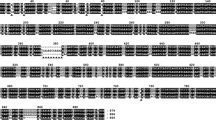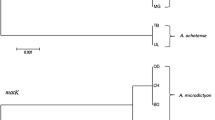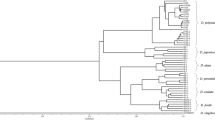Abstract
Genetic polymorphisms were investigated to develop a simple and rapid method to differentiate between the two closely related species, Porphyra tenera and Porphyra yezoensis. Polymerase chain reaction (PCR) using the specific primer pair of the ARP4 gene gave length polymorphic single fragments of genomic DNAs from five strains of P. tenera (Japan T-8, JTW; Korea KTY1, KTY2, KTY3) and seven strains of P. yezoensis (Japan TU-1, TU-2, TUH-25, JHU, JA-1; Korea KGJ, KPH). All strains of P. yezoensis had introns 60 bp longer than that of P. tenera. Multiple cleaved amplified polymorphic sequence (CAPS) markers were also developed to differentiate P. tenera and P. yezoensis. This is the first report of length polymorphisms that can be used to differentiate between the how species using only PCR amplification with agarose gel electrophoresis. It is expected that the length polymorphism and plentiful CAPS profiles obtained in this study will be useful in the assessment of genetic diversity within P. tenera and P. yezoensis as well as in breeding science that requires the collection of various strains of the two species.
Similar content being viewed by others
References
Miura A, Aruga Y. Distribution of Porphyra in Japan as affected by cultivation. J. Tokyo Univ. Fish. 1987; 74: 41–50.
Miura A. Taxonomic studies of Porphyra species cultivated in Japan, referring to their transition to the cultivated variety. J. Tokyo Univ. Fish. 1988; 75: 311–325.
Yoshida T, Kikuchi N, Yoshinaga K. Wild population of Porphyra tenera Kjellman. Jpn. J. Phycol. 1999; 47: 119–122.
Yoshida T. Porphyra tenera Kjellman. In: Environment Agency of Japan (ed.), Threatened Wildlife of Japan. Red Data Book, 2nd edn. Environment Agency of Japan, Tokyo. 2000; 218 (in Japanese).
Niwa K, Aruga Y. Rapid DNA extraction from conchocelis and ITS-1 rDNA sequences of seven strains of cultivated Porphyra yezoensis (Bangiales, Rhodophyta). J. Appl. Phycol. 2003; 15: 29–35.
Niwa K, Kikuchi N, Iwabuchi M, Aruga Y. Morphological and AFLP variation of Porphyra yezoensis Ueda form narawaensis Miura (Bangiales, Rhodophyta). Phycol. Res. 2004; 52: 180–190.
Niwa K, Aruga Y. Identification of currently cultivated Porphyra species by PCR-RFLP analysis. Fish. Sci.2006; 72: 143–148.
Niwa K, Kobiyama A, Aruga Y. Confirmation of cultivated Porphyra tenera (Bangiales, Rhodophyta) by polymerase chain reaction restriction fragment length polymorphism analysis of the plastid and nuclear DNA. Phycol. Res. 2005; 53: 296–302.
Tanaka T. The systematic study of the Japanese Protoflorideae. Mem. Fac. Fish., Kagoshima Univ. 1952; 2: 1–92, pl. I–XV.
Kurogi M. Species of cultivated Porphyras and their life histories. Bull. Tohoku Reg. Fish. Res. Lab. 1961; 18: 1–115.
Fukuhara E. Studies on the taxonomy and ecology of Porphyra of Hokkaido and its adjacent waters. Bull. Hokkaido Reg. Fish. Res. Lab. 1968; 34: 40–99.
Miura A. A new variety and a new form of Porphyra (Bangiales, Rhodophyta) from Japan: Porphyra tenera Kjellman var. tamatsuensis Miura, var. nov. and P. yezoensis Ueda form narawaensis Miura, form. nov. J. Tokyo Univ. Fish. 1984; 71: 1–14, pl. I–XI.
Niwa K, Kikuchi N, Aruga Y. Morphological and molecular analysis of the endangered species Porphyra tenera (Bangiales, Rhodophyta). J. Phycol. 2005; 41: 294–304.
Aruga Y. Color of the cultivated Porphyra. Our Nori Res. 1974; 23: 1–14 (in Japanese).
Hannach G, Waaland JR. Growth and morphology of young gametophytes of Porphyra abbottae (Rhodophyta): effects of environmental factors in culture. J. Phycol. 1989; 25: 247–254.
Stiller JW, Waaland JR. Molecular analysis reveals cryptic diversity in Porphyra (Rhodophyta). J. Phycol. 1993; 29: 506–517.
Stiller JW, Waaland JR. Porphyra rediviva sp. nov. (Rhodophyta): a new species from northeast Pacific salt marshes. J. Phycol. 1996; 32: 323–332.
Teasdale B, West A, Taylor H, Klein A. A simple restriction fragment length polymorphism (RELP) assay to discriminate common Porphyra (Bangiophyceae, Rhodophyta) taxa from the Northwest Atlantic. J. Appl. Phycol. 2002; 14: 293–298.
Park E-J, Fukuda S, Endo H, Kitade Y, Saga N. Genetic polymorphism within Porphyra yezoensis (Bangiales, Rhodophyta) and related species from Japan and Korea detected by cleaved amplified polymorphic sequence analysis. Eur. J. Phycol. 2007; 42: 29–40.
Yamazaki S, Iitsuka O, Kitade Y, Shin J-A, Saga N. Molecular phylogenetic study of Porphyra tenera and Porphyra yezoensis (Bangiales, Rhodophyta) using SSU rDNA. Fish Genet. Breed. Sci. 2003; 33: 25–34.
Kuwano K, Aruga Y, Saga N. Cryopreservation of clonal gametophytic thalli of Porphyra (Rhodophyta) Plant Sci. 1996; 116: 117–124.
Iitsuka O, Nakamura K, Ozaki A, Okamoto N, Saga N. Genetic information of three pure lines of Porphyra yezoensis (Bangiales, Rhodophyta) obtained by AFLP analysis. Fish. Sci. 2002; 68: 1113–1117.
Kitade Y, Nakamura M, Endo H, Fukuda S, Kuwano K, Saga N. Characterization of a cDNA encoding a homolog of actin-related protein 4 from a marine red alga Porphyra yezoensis. Fish. Sci. 2006; 72: 639–645.
Padgett RA, Grabowski PJ, Konarska MM, Seiler S, Sharp PA. Splicing of messenger RNA precursors. Annu. Rev. Biochem. 1986; 55: 1119–1150.
Kunimoto M, Kito H, Kaminishi Y, Mizukami Y, Murase N. Molecular divergence of the SSU rRNA gene and internal transcribed spacer 1 in Porphyra yezoensis (Rhodophyta). J. Appl. Phycol. 1999; 11: 211–216.
Kunimoto M, Kito H, Yamamoto Y, Cheney DP, Kaminishi Y, Mizukami Y. Discrimination of Porphyra species based on small subunit ribosomal RNA gene sequence. J. Appl. Phycol. 1999; 11: 203–209.
Kunimoto M, Kito H, Mizukami Y, Murase N, Levine I. Molecular features of a defined genetic marker for the determination of the Porphyra tenera lineage. J. Appl. Phycol. 2003; 15: 337–343.
Park E-J, Fukuda S, Endo H, Kitade Y, Saga N. Identification of cross-fertilized conchocelis using cleaved amplified polymorphic sequence markers in cross-experiments of Porphyra yezoensis (Bangiales, Rhodophyta). J. Phycol. 2008; 44 (in press).
Miura A, Fu PF, Shin J-A. Interspecific cross experiments between Porphyra yezoensis Ueda and P. tenera Kjellman (Bangiales, Rhodophyra) by using pigmentation variants. J. Tokyo Univ. Fish. 1992; 79: 103–120.
Author information
Authors and Affiliations
Corresponding author
Rights and permissions
About this article
Cite this article
Park, EJ., Endo, H., Kitade, Y. et al. Simple differentiation of two closely related species Porphyra tenera and Porphyra yezoensis (Bangiophyceae, Rhodophyta) based on length polymorphism of actin-related protein 4 gene (ARP4). Fish Sci 74, 613–620 (2008). https://doi.org/10.1111/j.1444-2906.2008.01565.x
Received:
Accepted:
Issue Date:
DOI: https://doi.org/10.1111/j.1444-2906.2008.01565.x




